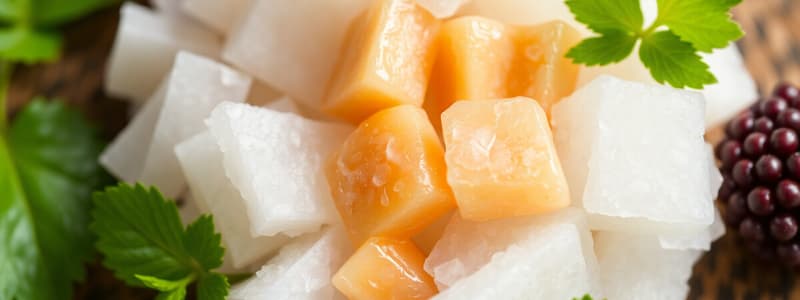Podcast
Questions and Answers
What is the primary characteristic that distinguishes amylose from amylopectin?
What is the primary characteristic that distinguishes amylose from amylopectin?
- Amylose is linked by 1,4-glycosidic bonds. (correct)
- Amylose is soluble in cold water.
- Amylose is linked by α-1,6-glycosidic bonds.
- Amylose is composed of branched chains.
Which of the following statements about cellulose is true?
Which of the following statements about cellulose is true?
- Cellulose changes color when exposed to iodine.
- Cellulose can be digested by most mammals.
- Cellulose is predominantly found in fruits.
- Cellulose yields glucose upon complete hydrolysis. (correct)
What is the general formula for glucose?
What is the general formula for glucose?
- C5H10O5
- C3H6O3
- C6H12O6 (correct)
- C6H14O7
What color change occurs when iodine is added to starch?
What color change occurs when iodine is added to starch?
Which of the following is NOT a product obtained from cellulose?
Which of the following is NOT a product obtained from cellulose?
Which of the following correctly describes ribose?
Which of the following correctly describes ribose?
What product do hexoses yield when treated with concentrated sulfuric acid in Molisch's test?
What product do hexoses yield when treated with concentrated sulfuric acid in Molisch's test?
Which carbohydrate is the C-4 epimer of glucose?
Which carbohydrate is the C-4 epimer of glucose?
Which of the following sugars is specifically known as levulose?
Which of the following sugars is specifically known as levulose?
What percentage of starch is typically made up of amylopectin?
What percentage of starch is typically made up of amylopectin?
What's the primary function of starch in plants?
What's the primary function of starch in plants?
Which of the following properties applies to both starch and cellulose?
Which of the following properties applies to both starch and cellulose?
What type of linkage connects the two monosaccharides in lactose?
What type of linkage connects the two monosaccharides in lactose?
Which characteristic is unique to heteroglycans compared to homoglycans?
Which characteristic is unique to heteroglycans compared to homoglycans?
What type of acid is formed when glucose is oxidized?
What type of acid is formed when glucose is oxidized?
What does lactose intolerance indicate about an individual's ability to digest certain sugars?
What does lactose intolerance indicate about an individual's ability to digest certain sugars?
What is the characteristic of chitin?
What is the characteristic of chitin?
Which chemical is used in Molisch's test to detect carbohydrates?
Which chemical is used in Molisch's test to detect carbohydrates?
What is the main purpose of Benedict's reagent?
What is the main purpose of Benedict's reagent?
What type of solution is Fehling’s solution A?
What type of solution is Fehling’s solution A?
Which reaction produces a silver mirror during testing?
Which reaction produces a silver mirror during testing?
What is the primary function of glycogen in the body?
What is the primary function of glycogen in the body?
What color change is observed when iodine reacts with starch?
What color change is observed when iodine reacts with starch?
Which component is NOT part of Benedict's reagent?
Which component is NOT part of Benedict's reagent?
Which of the following best describes glycoproteins?
Which of the following best describes glycoproteins?
What type of sugars does Fehling's Test primarily detect?
What type of sugars does Fehling's Test primarily detect?
What is a key characteristic of glycosaminoglycans?
What is a key characteristic of glycosaminoglycans?
What role does heparin serve in the body?
What role does heparin serve in the body?
Which statement is true about reducing sugars?
Which statement is true about reducing sugars?
What distinguishes proteoglycans from glycoproteins?
What distinguishes proteoglycans from glycoproteins?
Which statement about the hydrolysis of glycogen is accurate?
Which statement about the hydrolysis of glycogen is accurate?
Which carbohydrate is classified as a non-reducing sugar?
Which carbohydrate is classified as a non-reducing sugar?
Flashcards are hidden until you start studying
Study Notes
Glucose
- Most important sugar in the human body.
- Also known as dextrose, grape sugar, and blood sugar.
- Normal blood glucose level is 100-120 mg/ 100ml.
- Regulated by insulin and glucagon.
- Has an aldehyde group and five hydroxyl groups.
- Can form an intramolecular cyclic hemiacetal.
Galactose
- Found in the disaccharide, lactose.
- Found in the cellular membranes of the brain and nervous system.
- Is the C-4 epimer of glucose.
Fructose
- Also known as levulose.
- Found in honey, corn syrup, and sweet fruits.
Ribose
- Ribose and deoxyribose are the building blocks of nucleic acids (DNA and RNA).
- Ribose is used in RNA and deoxyribose is used in DNA.
- Deoxyribose lacks an alcohol (-OH) group.
- Makes up RNA and coenzymes.
Aldose Oxidation Reactions
- Aldoses can be oxidized to three types of acids: aldonic acids, uronic acids, and saccharic acids.
- Aldonic acids: Aldehyde group is converted to a carboxyl group (glucose - gluconic acid).
- Uronic acids: Aldehyde is left intact and primary alcohol at the other end is oxidized to COOH (glucose - glucuronic acid, galactose - galacturonic acid).
- Saccharic acids (glycaric acids): Oxidation at both ends of the monosaccharide (glucose - saccharic acid, galactose - mucic acid, mannose - mannaric acid).
Disaccharides
- Lactose: Found in mammalian milk. Made up of β-d-galactose and β -d-glucose. Has β(1 4) linkage. Lactose intolerance is the inability to digest lactose.
- Maltose: Also known as malt sugar. A reducing sugar. Linked through α(1 4) linkage.
- Sucrose: Known as table sugar, cane sugar. Made up of α–glucose and β–fructose. Linked through α1 → β2 glycosidic bond.
Chitin
- Second most abundant carbohydrate polymer.
- Present in the cell wall of fungi and exoskeletons of crustaceans, insects, and spiders.
- Used commercially in coatings to extend the shelf life of fruits and meats.
- Derived from the condensation of two glucose molecules linked in a β(1→4) bond.
- Derived from cellulose.
Polysaccharides (Glycans)
- Types: Homoglycans / homopolysaccharides (starch, cellulose, glycogen, inulin) and Heteroglycans / heteropolysaccharides (gums, uronic acid, amino sugars, mucopolysaccharides).
- Characteristics: Polymers (MW from 200,000), white and amorphous products (glossy), not sweet, form colloidal solutions or suspensions.
Cellulose
- Polymer of β-d-glucose attached by β(1-->4) linkages.
- Only digested and utilized by ruminants (cows, deers, giraffes, and camels).
- A structural polysaccharide.
- Yields glucose upon complete hydrolysis.
- Partial hydrolysis yields cellobiose.
- Most abundant of all carbohydrates.
- Cotton flax: 97-99% cellulose. Wood: ~ 50% cellulose.
- Gives no color with iodine.
Products obtained from cellulose
- Microcrystalline cellulose: Used as binder-disintegrant in tablets.
- Methylcellulose: Suspending agent and laxative.
- Oxidized cellulose: Hemostat.
- Sodium carboxymethyl cellulose: Laxative.
- Cellulose acetate: Rayon; photographic film; plastics.
- Cellulose acetate phthalate: Enteric coating.
- Nitrocellulose: Explosives.
Starch
- Most common storage polysaccharide in plants.
- Composed of 10–30% α-amylose and 70-90% amylopectin depending on the source.
- Chains are of varying length with molecular weights from several thousands to half a million.
- Main sources of starch are rice, corn, wheat, and potatoes.
- A storage polysaccharide.
- Used as an excipient, a binder in medications to aid the formation of tablets.
- Industrial applications include adhesives, paper making, biofuel, and textiles.
Amylose
- Made of several d-glucose units linked by 1,4-glycosidic bonds.
- Turns dark blue or black with iodine.
- Soluble in water and can be hydrolyzed into glucose units by α-amylase and β-amylase.
Amylopectin
- Polymer of several d-glucose molecules.
- 80% of amylopectin is present in starch.
- Linked by α-1,4-glycosidic bonds and α-1,6-glycosidic bonds.
- Turns reddish-brown with iodine.
- Readily dissolves in hot water and forms a starch paste or starch gel on cooling.
Glycogen
- Also known as animal starch.
- Stored in muscle and liver (mostly).
- Present in cells as granules (high molecular weight).
- Contains both α(1,4) links and α(1,6) branches at every 8 to 12 glucose units (more frequent than in starch).
- Complete hydrolysis yields glucose.
- Hydrolyzed by both α and β-amylases and by glycogen phosphorylase.
Glycoproteins and Proteoglycans
- Glycoproteins: Proteins conjugated to saccharides lacking a serial repeating unit. Protein >> carbohydrate. Examples include enzymes, immunoglobulins (antibodies), and certain hormones.
- Proteoglycans: Proteins conjugated to polysaccharides with serial repeating units. Carbohydrate >> protein. Modulate cell processes and make cartilage flexible and resilient.
Glycosaminoglycans
- Polysaccharide chains of proteoglycans.
- Linked to the protein core via a serine or threonine (o-linked).
- Linear (unbranched) chains.
- Long chains (over 100 monosaccharides).
- Composed of repeating disaccharides.
Heparin I and II
- Highly sulfated glycosaminoglycan.
- Widely used as an injectable anticoagulant.
- Has the highest negative charge density of any known biological molecule.
- Most common disaccharide unit is composed of a 2-o-sulfated iduronic acid and 6-o-sulfated, n-sulfated glucosamine, IdoA(2S)-GlcNS(6S).
Other Important Glycosaminoglycans
- Uronic acid: Sugar acids.
- α-d-glucuronic acid: Found in liver cells and is bonded to hydrophobic steroids increasing solubility of steroids.
- Amino sugars:
- N-acetylglucosamine: Important component of the cell wall.
- N-acetyl galactosamine: Component in blood antigens.
- Chondroitin sulfate: Component of cartilage and heparin.
- Hyaluronic acid: Abundant in the vitreous humor of the eye and joints.
Carbohydrate Reactions
- Reducing sugars: Carbohydrates that can reduce Tollens, Benedict’s or Fehling’s reagents. All monosaccharides and most of the disaccharides are reducing sugars (e.g., maltose and lactose).
- Non-reducing sugars: Carbohydrates that cannot reduce Tollens’, Benedict’s or Fehling’s reagents. Sucrose is a non-reducing sugar.
Molisch’s Test
- A general test for carbohydrates.
- Monosaccharides undergo dehydration with concentrated sulfuric acid to form furfural (furfuraldehyde) that reacts with α-naphthol to form a violet-colored product.
Fehling's Test
- Detects the presence of reducing sugars.
- Fehling’s solution a is copper sulphate solution and Fehling’s solution b is potassium sodium tartrate.
- Upon heating, carbohydrate reduces deep blue solution of copper (ii) ions to red precipitate of insoluble copper oxide.
Benedict's Reaction
- Standard laboratory test for follow-up of diabetes mellitus (glucosuria).
- Benedict's reagent contains sodium carbonate, copper sulfate, and sodium citrate.
- In alkaline medium, sugars form enediol, cupric ions are reduced, and sugar is oxidized.
- Glucose is a reducing sugar. Any sugar with a free aldehyde/keto group will reduce the Benedict’s reagent. Therefore, this is not specific for glucose.
Tollens’ Test
- Tollens’ reagent is ammoniacal silver nitrate solution.
- On reacting with carbohydrates, elemental silver is precipitated out of the solution, occasionally onto the inner surface of the reaction vessel.
- This produces a silver mirror on the inner wall of the reaction vessel.
Iodine Test
- Used to detect the presence of starch.
- Iodine reacts with starch to form a starch/iodine complex which gives a characteristic blue-black color to the reaction mixture.
Studying That Suits You
Use AI to generate personalized quizzes and flashcards to suit your learning preferences.




